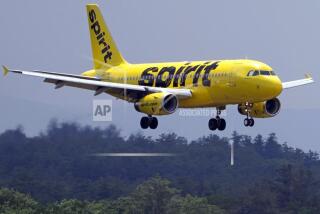Owner of L.A. Times files for bankruptcy
- Share via
In perhaps the starkest sign yet of trouble in the news business, media giant Tribune Co. -- owner of the Los Angeles Times, KTLA-TV Channel 5 and other newspapers and TV stations -- filed Monday for bankruptcy protection from creditors.
Tribune’s woes stem from a combination of plunging advertising revenue and a heavy debt load of $12.9 billion, much of it incurred a year ago when it was taken private by Chicago real estate entrepreneur Sam Zell.
Tribune is far from being the only troubled media company. In the last week alone, the New York Times said it would mortgage its Manhattan headquarters for as much as $225 million to help cover operating costs, industry leader Gannett Co. pushed ahead with the layoff of 2,000 employees, and Denver’s Rocky Mountain News and the Miami Herald were put up for sale.
“Everywhere you go, it’s the same story,” said Alan Mutter, a veteran newspaper editor and investor who writes the Newsosaur blog. “It’s all kind of appalling.”
But Tribune has become the first major news organization to file for bankruptcy, which could add a new dimension of uncertainty for the company and its 16,000 employees. During a Chapter 11 bankruptcy reorganization, major management decisions must pass muster with a bankruptcy judge, and the ultimate fate of a company -- including whether it remains intact or is sold off in pieces -- could be decided in part by its creditors.
Zell said Monday that Tribune’s business units would operate as normal and that the focus of the reorganization would be “on our debt, not on our operations.”
In its filing in Bankruptcy Court in Delaware, the company, which owns eight metropolitan daily newspapers and 23 television stations, said it had $7.6 billion in assets and debt of $12.9 billion.
Among the company’s top creditors were the banks that had lent it more than $8 billion to complete the Zell deal, including JPMorgan Chase & Co., Deutsche Bank and Merrill Lynch & Co.
Another top creditor is Mark Willes, the former chief executive of Times Mirror Co., who is owed $11.2 million in deferred compensation from his severance package of more than $64 million, dating from Tribune’s acquisition of Times Mirror in 2000.
Industry analyst Ken Doctor of Outsell Inc. said Tribune “stands out like a sore thumb because of its outsize debt, which is far greater than any other newspaper company’s.” But Zell and other corporate executives said the company had a positive cash flow before debt service was taken into account. Its largest units, including The Times, are profitable on the same basis.
“The focus of the filing today is 100% on relieving the pressure on the company from its debt,” Zell told reporters. “By virtue of the filing today we will suspend making interest payments, which should give us added flexibility in order to continue moving forward.”
The company has been considering the possible purchase of the Orange County Register and the San Diego Union-Tribune in an effort to consolidate the Southern California market for print and online advertising.
Zell did not address any acquisition talks with Register owner Freedom Communications Inc. or Copley Press Inc., which owns the Union-Tribune. In response to a question about those possible purchases, he said that strategically sound deals probably would be approved by the bankruptcy judge.
Despite their struggles, many newspapers remain profitable. Before the bankruptcy filing, the Los Angeles Times projected it would make $100 million this year, down from about $240 million two years ago.
And newspapers are rapidly gaining millions of new readers on the Internet, although the ad revenue from online news has not kept pace.
With Tribune now in bankruptcy protection, its creditors will have to decide whether they’re willing to restructure the debt, as Zell hopes, or try to get at least some of their money back another way, such as by a sale of its assets.
A breakup seems unlikely, however. Even if buyers were to emerge for some of the company’s media properties, financing such purchases could be a major stumbling block given that credit remains tight.
In many bankruptcies, creditors exchange debt for an ownership stake in the business, in the hope of eventually selling that stake at a profit. Barring a breakup of the company, the issue facing Tribune’s creditors could come down to how much of a debt load to leave on the company’s balance sheet and how much of an equity stake to demand.
Tribune directors approved the action to file Chapter 11 in a meeting Monday, just as a $70-million payment on a medium-term loan was coming due. Although Tribune had about $300 million cash on hand, more than enough to make the installment payment, executives had been trying to achieve a broad restructuring of its debt in conjunction with the payment.
Those efforts failed in part because economic conditions have made projecting the course of the company’s revenue and earnings exceptionally difficult: Not only are projections of the length and depth of the recession hard to come by, but also the continuing credit crunch has injected uncertainty into even routine business transactions.
Tribune reported last month that its operating revenue for the third quarter ended Sept. 30 decreased 10%, to $1 billion, as advertising revenue fell 19% compared with a year earlier.
Tribune’s debt service costs have been running at about $1 billion a year. A $512-million principal payment related to the buyout is due in June.
Money for that payment was to come from asset sales, particularly the sale of the Chicago Cubs baseball franchise. That sale has been delayed in part because of the credit crisis and is now expected to take place in 2009.
Some analysts have estimated the value of the Cubs, the team’s landmark Wrigley Field ballpark and other associated real estate at more than $1 billion. The Cubs and the related properties were excluded from the bankruptcy filing, the company said, to enable the sale to proceed.
The big losers in the Tribune bankruptcy may be banks and bond investors that funded Zell’s buyout.
The credit analysis firm Fitch Ratings said Monday that the bank lenders that provided the bulk of the financing might recover as little as 31% of the investments.
For other debt holders, Fitch said, “0% recovery is realistic.”
The bond market had anticipated Tribune’s looming distress. As recently as two weeks ago, some Tribune bonds were trading as low as 14 cents on the dollar.
In most corporate bankruptcies, the holdings of equity investors are largely wiped out. In Tribune’s case, all of the company’s equity is held by an employee stock ownership plan, or ESOP. As yet, the company has not allocated any shares in the ESOP to employees.
Tribune said it hoped to preserve the ESOP structure, which gives it valuable tax exemptions.
--
Times staff writers Tom Petruno and Tiffany Hsu contributed to this report.
--
(BEGIN TEXT OF INFOBOX)
Tribune Co. at a glance
The Chicago company, founded in 1847, is now controlled by real estate magnate Sam Zell.
Newspapers: Los Angeles Times, Chicago Tribune, Baltimore Sun and five other metropolitan dailies
Broadcasting: Twenty-three television stations including KTLA-TV Channel 5, as well as cable station WGN America
Sports: The Chicago Cubs baseball team, which is for sale and not part of the bankruptcy
Employees: About 16,000
What’s next: The company wants to renegotiate its debt with lenders and other creditors under the supervision of the Bankruptcy Court. Creditors will have to decide how much of a break they’re willing to give the company and what to demand in return. Typically in Chapter 11 bankruptcies, creditors exchange some portion of the debt for partial or total ownership of the business. The renegotiation process can take many months.
Sources: Tribune Co., Times research
More to Read
The biggest entertainment stories
Get our big stories about Hollywood, film, television, music, arts, culture and more right in your inbox as soon as they publish.
You may occasionally receive promotional content from the Los Angeles Times.











